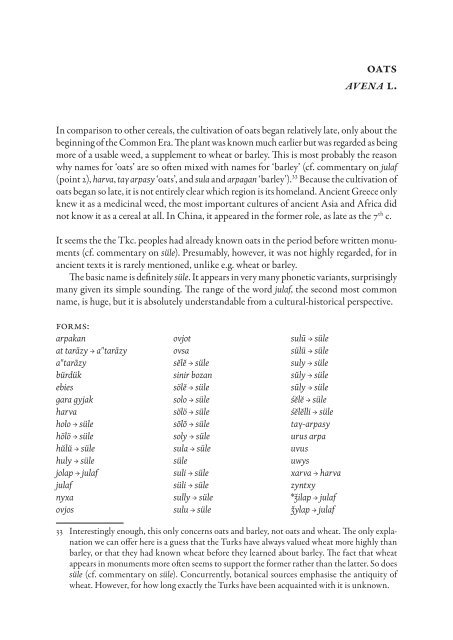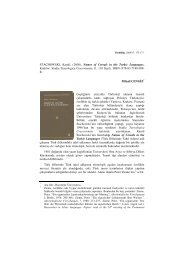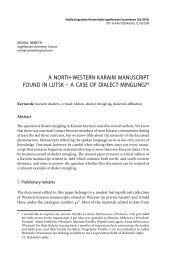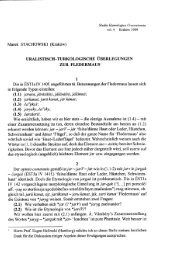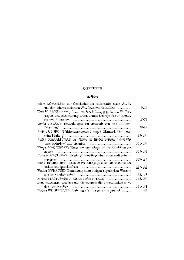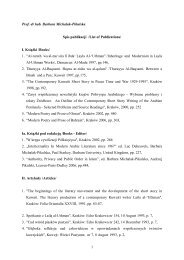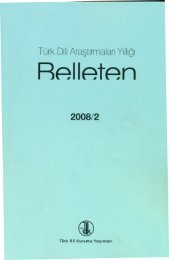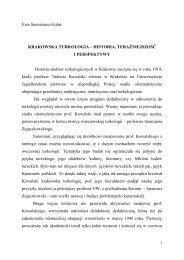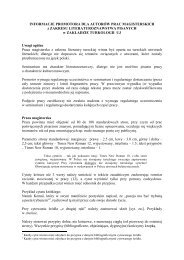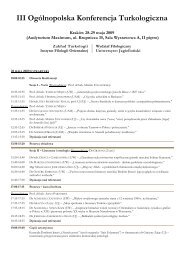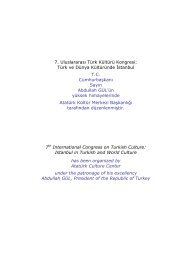Names of Cereals in the Turkic Languages - Wydział Filologiczny UJ
Names of Cereals in the Turkic Languages - Wydział Filologiczny UJ
Names of Cereals in the Turkic Languages - Wydział Filologiczny UJ
- No tags were found...
Create successful ePaper yourself
Turn your PDF publications into a flip-book with our unique Google optimized e-Paper software.
oatsavena l.In comparison to o<strong>the</strong>r cereals, <strong>the</strong> cultivation <strong>of</strong> oats began relatively late, only about <strong>the</strong>beg<strong>in</strong>n<strong>in</strong>g <strong>of</strong> <strong>the</strong> Common Era. The plant was known much earlier but was regarded as be<strong>in</strong>gmore <strong>of</strong> a usable weed, a supplement to wheat or barley. This is most probably <strong>the</strong> reasonwhy names for ‘oats’ are so <strong>of</strong>ten mixed with names for ‘barley’ (cf. commentary on julaf(po<strong>in</strong>t 2), harva, taγ arpasy ‘oats’, and sula and arpagan ‘barley’). 33 Because <strong>the</strong> cultivation <strong>of</strong>oats began so late, it is not entirely clear which region is its homeland. Ancient Greece onlyknew it as a medic<strong>in</strong>al weed, <strong>the</strong> most important cultures <strong>of</strong> ancient Asia and Africa didnot know it as a cereal at all. In Ch<strong>in</strong>a, it appeared <strong>in</strong> <strong>the</strong> former role, as late as <strong>the</strong> 7 th c.It seems <strong>the</strong> <strong>the</strong> Tkc. peoples had already known oats <strong>in</strong> <strong>the</strong> period before written monuments(cf. commentary on süle). Presumably, however, it was not highly regarded, for <strong>in</strong>ancient texts it is rarely mentioned, unlike e.g. wheat or barley.The basic name is def<strong>in</strong>itely süle. It appears <strong>in</strong> very many phonetic variants, surpris<strong>in</strong>glymany given its simple sound<strong>in</strong>g. The range <strong>of</strong> <strong>the</strong> word julaf, <strong>the</strong> second most commonname, is huge, but it is absolutely understandable from a cultural-historical perspective.forms:arpakanat tarāzy → a"tarāzya"tarāzybürdükebiesgara gyjakharvaholo → sülehölö → sülehŭlŭ → sülehuly → sülejolap → julafjulafnyxaovjosovjotovsasĕlĕ → süles<strong>in</strong>ir bozansölĕ → sülesolo → sülesölö → sülesōlō → sülesoly → sülesula → sülesülesuli → sülesüli → sülesully → sülesulu → sülesulū → sülesülü → sülesuly → sülesŭly → sülesūly → süleśĕlĕ → süleśĕlĕlli → sületaγ-arpasyurus arpauvusuwysxarva → harvazyntxy*ǯilap → julafǯylap → julaf33 Interest<strong>in</strong>gly enough, this only concerns oats and barley, not oats and wheat. The only explanationwe can <strong>of</strong>fer here is a guess that <strong>the</strong> Turks have always valued wheat more highly thanbarley, or that <strong>the</strong>y had known wheat before <strong>the</strong>y learned about barley. The fact that wheatappears <strong>in</strong> monuments more <strong>of</strong>ten seems to support <strong>the</strong> former ra<strong>the</strong>r than <strong>the</strong> latter. So doessüle (cf. commentary on süle). Concurrently, botanical sources emphasise <strong>the</strong> antiquity <strong>of</strong>wheat. However, for how long exactly <strong>the</strong> Turks have been acqua<strong>in</strong>ted with it is unknown.


